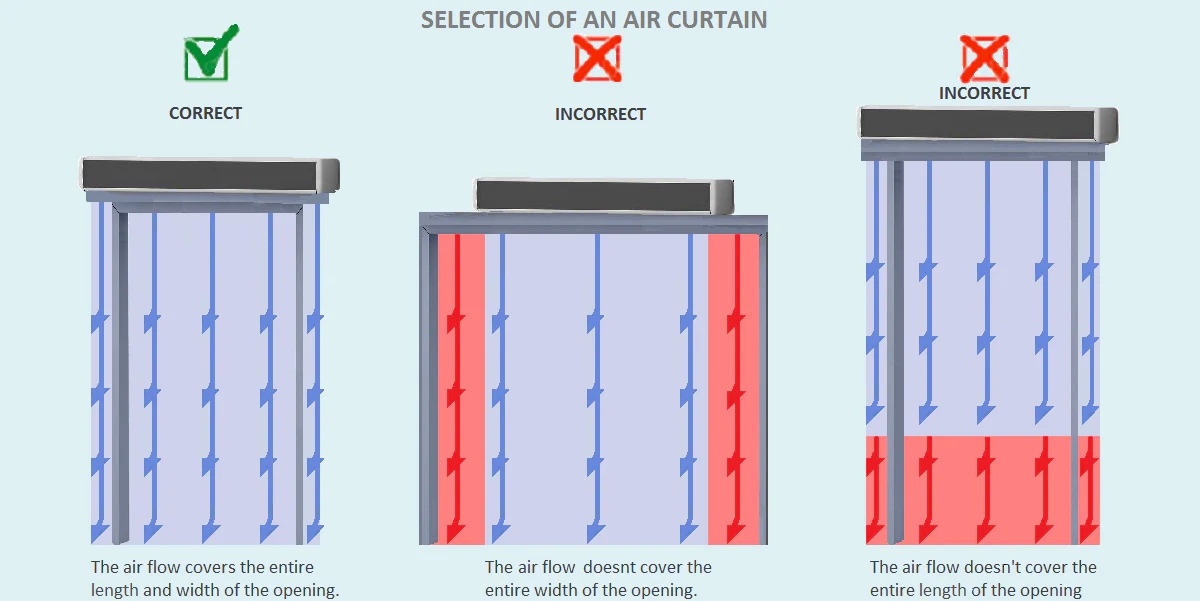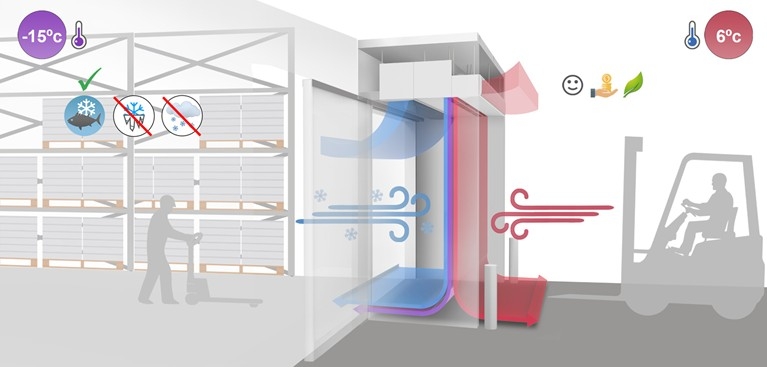An air curtain is a device that separates two zones/areas with different temperatures by creating an invisible curtain with the air flow, thus maintaining the quality of the conditioned air in the indoor environment.

The air curtain device is positioned on the top or side of the entrance and covers the entire door section with the air flow created and prevents the hot - cold or dirty air that may come into the environment from outside, as well as the negative factors of the external environment (dust, flies, smoke, humidity, etc.) from entering.
A door heater consisting of a low-flow fan and a small capacity heater placed on the door in some stores only heats that area, while an air curtain saves energy by preventing heat escape with the strong current it provides.
In order to get maximum efficiency from the air curtain, there must be air balance in the building. If there is positive or negative pressure in the building, it is not possible for the air curtain to prevent air intake or air escape, but the comfort conditions of the indoor air are maintained as it will allow the incoming air to enter by heating.
What is the advantage?
• Doors Can Stay Open
The invisible curtain created by using fast air flow allows people to easily enter and exit the building without being blocked by the doors. Therefore, the use of air curtains is recommended wherever the door is to be kept open.
• Reduces Airflow and Discomfort
It avoids disturbing staff, customers and visitors near the door from the air flow coming from outside.
• Saves Energy
It is possible to reduce the operating costs of heating and cooling systems with air curtains. It supports the heat insulation system used for energy efficiency in buildings. At the same time, it increases the service life of these devices by ensuring that building heating and cooling systems operate less.
• Improves Indoor Air Quality
The impact of external factors such as insects, pollen, smoke and dust on indoor quality is minimized.

|
Entrance without Air Curtain |
Entrance with Air Curtain |
|
|
Conditioned air and outdoor air easily mix with each other, causing energy loss and reducing indoor air quality. |
The correctly selected air curtain creates a sharp separation between different temperature zones. It creates a barrier that effectively prevents unwanted air flows. |

(Figure-1) (Figure-2) (Figure-3)
The efficiency of the air curtain is inversely proportional to the internal - external pressure and temperature differences and wind speed. In a proper installation, the airflow generated by the air curtain should cover the entire opening it is installed to protect (Figure-1). If the air curtain is not wide, it cannot generate a large enough air flow to fully protect the opening mounted on top, thus increasing the heating or cooling costs of the space as a result of leakage (Figure-2).The same applies to the height of the air curtain (Figure-3). If the air curtain is oversized for the door to be used, it will result in additional energy use without any additional benefit to the consumer.
Heat loss at the entrance of a building can be caused by mechanical ventilation, natural ventilation and natural convection. Descriptions of these losses are given here.
Mechanical Ventilation
When using a mechanical ventilation system, the interior of the building or a zone inside the building can be pressurized in three different conditions. Positive pressurized, negative pressurized or pressurized (no pressure difference between zones). These pressure differences in the openings between zones can be the result of an unbalanced ventilation system, ineffective controls or, in some cases, design. Air curtain solutions can work in these scenarios. However, the highest efficiency is achieved when the pressure difference between zones is zero.
Natural Ventilation
Buildings are not completely airtight. Openings in buildings, such as doors, windows and cracks, naturally allow warm air to escape and cold air to replace it. This natural ventilation can be enhanced by the wind conditions and direction in the door zones. The use of an air curtain in this scenario reduces the effects of heat loss due to wind-driven natural ventilation.
Natural Convection
Cold air is much heavier than warm air, allowing the warm air to rise. Along an undisturbed boundary between a heated space and a cold space, warm air will escape from the top of the opening. This process will naturally cause cooler air to enter the heated space from near ground level, known as natural convection. Under these conditions, an air curtain can limit the air exchange between the two zones by creating a barrier to impede airflow.
Energy Use and Costs
Maintaining a temperature in a region through heating or cooling is costly. This cost can be seen in two ways: the energy required to achieve that temperature and the associated monetary value. The graph below compares the relative costs, both energy and financial, of various options and the consequences of using a suitable or poorly chosen air curtain solution. For businesses with an open door policy in energy use and energy expenditure, the effects of using a properly selected air curtain solution are clearly visible.





